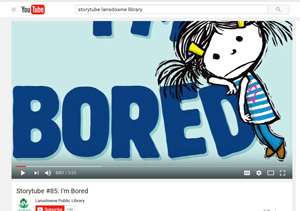 At Lansdowne Public Library, we have the traditional, on-site story time hours—one for infants, one for toddlers, and one for preschoolers. To accommodate families who cannot attend, we have learned to embrace technology to make the joy of read-alouds accessible.
At Lansdowne Public Library, we have the traditional, on-site story time hours—one for infants, one for toddlers, and one for preschoolers. To accommodate families who cannot attend, we have learned to embrace technology to make the joy of read-alouds accessible.
The result is “Storytubes,” a collaboration between our former Public Services librarian, Abbe Klebanoff, and me, which showcases videos on the library’s YouTube channel of picture books being read and performed by me or by special guest readers.
But why take the time for these Storytubes? There are many benefits of reading aloud such as fostering growth of attention span and exposing children to a more complicated vocabulary and sophisticated text. Reading aloud models fluency and expression and builds skills in speaking, writing, reading, and comprehension. Reading aloud also motivates children to read for a lifetime rather than just for school and, most important, it engenders a love for reading and books: a foundation for pleasure and lifelong education. But how does one read aloud? It seems as if it would be as simple as picking a book. To ensure success when reading aloud, follow these steps:
Plan ahead
Get to know the book: Always read it to yourself before reading to your reader. This may seem like a nonissue, but I will admit that there have been times when, in a rush, I have pulled a book I have used before and did a quick skim to try and refresh my memory only to find the book was not quite what I remembered. There can be complicated language that does not allow for reading upside down or aloud without much practice! There could be a page missing—library books are very well loved! Save yourself from surprise and prepare!
Be dramatic!
Be mindful of pace and expression. Match your tone, expression, and pace to what is happening in the story and how the characters are feeling. Use your body and face to convey expression and use your voice for intonation, pauses, and changes in volume. My favorite memory of being read to as a child is of my mother dramatically reading and acting out Richard Scarry's Nursery Rhymes. She would assign parts to my sister and me, and we would act out each story. I have carried on this practice, pretending each book is a script and I am on stage.
Involve your audience
At certain points during a story, there are natural parts when it’s possible to pause and ask the child or children to make a prediction about what will happen next or to share a connection to the text. It's not always feasible and sometimes not necessary, but it's a wonderful way to gauge how much the child comprehends. Having children respond a few times during a story to predict, visualize, or make a connection will help them learn to use those strategies as they read to themselves, strengthening comprehension.
Take time to share the illustrations
Practice reading the book with the illustrations facing toward your audience as you read. Upside down reading does become easier the more you practice! However, if reading while facing the book to the audience is difficult, that’s OK—it would be better to read smoothly and then turn the book toward your audience. Before turning the page each time, pause to make sure all students have seen the illustrations—with picture books, the illustrations help readers fully visualize and comprehend the story.
Most of all, have fun!
My rule of thumb is that if it's not fun for everyone, including you as the reader, your audience will know. It's OK to come back to a book or—gasp!—not finish reading it at all!
Parents say Storytubes help prepare their children for a visit to the library, provide an alternative to commercial videos, and offer opportunities for new ways to share favorite books. Children also visit the library to search for books featured in the videos to mirror their own readings. Fellow librarians say Storytubes offer new ideas to refresh their story time programs. One loyal library visitor who is a reading specialist says the video gave him an opportunity to present picture books in ways he had not considered. Our Storytubes are also encouraging caretakers and children to listen and learn that storytelling is a dramatic art form as well as a tradition. Recording storytelling helps carry the tradition through generations.
 Rachee Fagg is head of children’s services at the Lansdowne Public Library in Lansdowne, PA.
Rachee Fagg is head of children’s services at the Lansdowne Public Library in Lansdowne, PA.